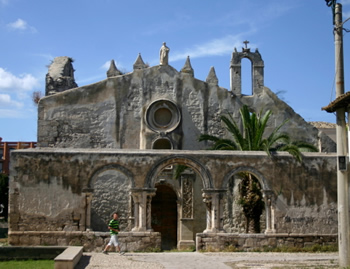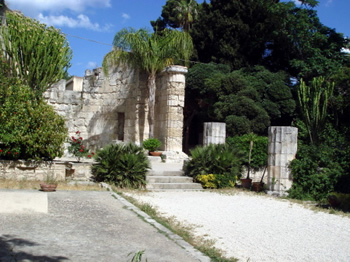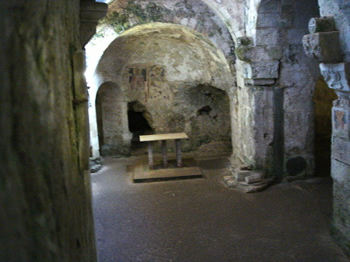
 |
| The facade of San Giovanni Evangelista in Syracuse, built in the 18th century re-using material from the 14th century. |
The complex of San Giovanni Evangelista (St. John the Evangelist) in Syracuse: (Catacombs, Crypt, Church)
In an area that had been Roman catacombs, in which, according to tradition, the first bishop of Syracuse, the holy martyr Marziano (or Marciano, 3rd century A.D.) was buried, a place of Christian worship arose in late antiquity, traces of which remain in an ancient crypt that still exists.
Abandoned during the Arab occupation of Sicily and rebuilt in the Norman period around 1092, the building finally collapsed during the earthquake of 1693.
Fragments of the remains were then recovered to partially rebuild the church, on a smaller area and rotated in orientation (that is to say, what today looks like the front was the right side of the original church). The beautiful portico in front of the facade was built using recovered material, which dates from the 14th century.
The Ruins
of the Church of San Giovanni Evangelista
 |
| What remains of the Norman church of San Giovanni Evangelista in Syracuse. |
The area containing these buildings is now one museum complex, which one can visit in groups accompanied by a guide (it is possible to reserve in advance).
The first area into which one enters contains the ruins of the church, where the ceiling is completely missing and which is now occupied in part by a lush garden.
The remains of the building’s Norman columns reveal that it made use of models of the Greek Doric columns visible in the Duomo, but it is even possible that some parts of them are actually authentic Greek columns, stripped from a former temple to Demeter and Kore.
 |
| The crypt of San Marziano below the Church of San Giovanni Evangelista in Syracuse. |
A steep staircase, on the right side, provides the descent to the ancient crypt of San Marziano, which survived through the centuries and earthquakes.
The space, originally a hypogeum, was transformed
into a church around the 6th century, when the remains of San Marziano
were brought there, and after the period of Arab
rule in Sicily it was rebuilt in Norman times (the very beautiful capitals
of the four pillars that support it date from this era).
The crypt contains numerous frescoes,
unfortunately mostly in precarious states of conservation, which date from
the 5th century to the 17th century.
St. Paul, in one of his Epistles mentions
the fact of landing (as at the time it was normal for people traveling
to Italy from the East to do) right in Syracuse, during his voyage by sea
from Palestine to Rome, when making a plea before the Emperor for his trial.
St.
Paul stopped in Syracuse for three days.
Legend has it that on that occasion the
Holy Apostle would have found the time to visit the local community and
celebrate Mass on an altar, which according to tradition is the
one present in this crypt.
Although this story lacks any historical basis, the fact remains that this altar was a place of veneration of the memory of the apostle Paul since early Christianity, as evidenced by the decorations and inscriptions.
Catacombs of San Giovanni
(For information regarding the catacombs,
see
the dedicated page.)
How to Reach the complex of San Giovanni
Evangelista from the Algilà
Ortigia Charme Hotel.
The Catacombs of San Giovanni and the
ruins of the Church of San Giovanni Evangelista above are located a few
steps from the Museo
Archeologico Regionale “Paolo Orsi” and a short distance
from the Archaeological
Park of Syracuse off the island of Ortigia.
A route by foot is possible, but it will exceed one kilometer
/ 0.62 miles in distance.
Those who do not have their own transportation can call a taxi from the reception desk at a special rate or use the bicycles that the Hotel Algilà offers to its guests for free.
Alternatively, one can take the (free)
shuttle bus #20 from the nearby Piazza
Archimede up to the bus station (near the train station) and
then take either one of the following bus lines: 6, 8, 11, 12 or
13.
Otherwise, from Riva Nazario Sauro (behind
the nearby Piazza delle Poste) one can choose from the following bus lines
1, 2, 3, 4 or 12.
Visitor Information.
The opening and tours of the catacombs
and ruins of the church are entrusted to the
cooperative Kairòs (for information: Kairòs, tel.
/ fax (++39) 0932 64 694).
Visits take place in the form of guided
tours every 15 to 30 minutes, from Tuesday to Sunday, 9:00 a.m.-12:30 p.m.
and 2:30-4:30 p.m. (5:30 p.m. in the summer). Closed on Monday.
The guide, who is well prepared and kind
(although sometimes speaking a rather italianate kind of English), provides
an explanation of the history and significance of the site.
Groups led by a cleric can also book
the celebration of a Mass in the crypt of San Marziano.
The visit requires, calculating a possible wait for the group’s departure, no more than 30 minutes.
The catacombs, which are all on one level
with a bare floor, are free from significant architectural barriers, but
the entrance itself is via a steep staircase, which does not allow
access to people with difficulty walking without proper assistance.
The visit is not recommended for people
who suffer from claustrophobia, owing to the absence of an external opening.
Back to TOURISM IN SYRACUSE, SICILY